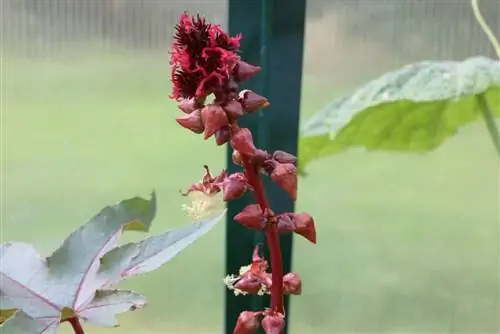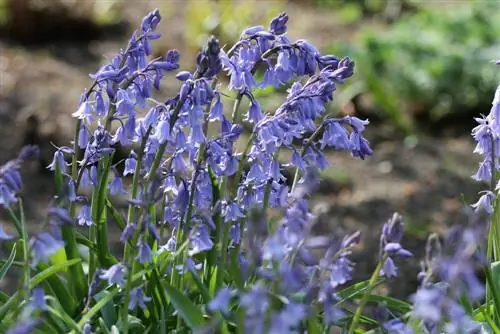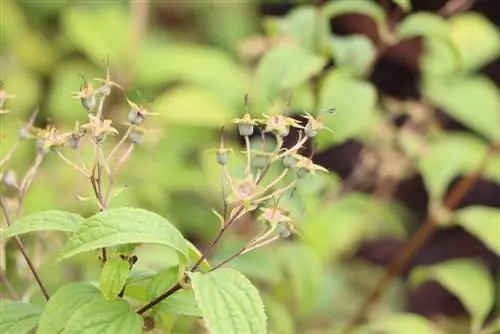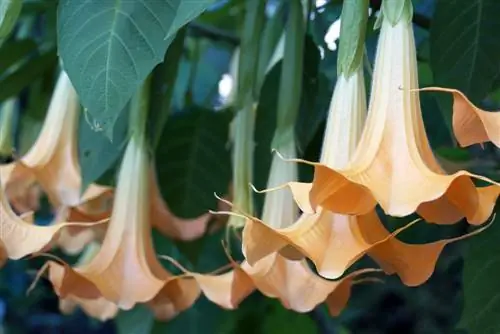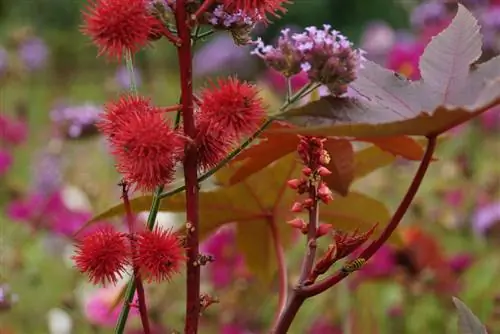- Author admin [email protected].
- Public 2023-12-17 03:39.
- Last modified 2025-01-24 12:45.
The miracle tree deserves its promising title with phenomenal attributes. The herbaceous spurge plant scores points with its rapid growth to a whopping 3 meters height within just a few months. No one can escape the mystical aura of its bright red leaves, shaped like a spread hand. Not forgetting the fluffy flowers followed by spectacular red spiky fruits. Although the seeds of a castor bean plant are highly toxic, they still provide valuable oil. Interested hobby gardeners will not miss the following tips on care and toxicity.
Location and substrate
The successful care of the tropical miracle tree under the local climatic conditions is based on the choice of an adequate location. The more protected the conditions, the more promising it is to expand what is actually an annual culture into a multi-year presence in the garden.
- Sunny location, warm and well protected from strong winds
- The intensity of the foliage color decreases in a partially shaded place
- nutrient-rich soil, humus and well-drained
- Fresh, moist and with a normal pH value
As a majestic potted plant, the castor bean plant perfectly decorates the large balcony, the spacious terrace or the sheltered seating area in the garden. In this case, a high-quality, structurally stable pot plant soil, which is optimized with compost and horn shavings, is suitable as a substrate.
Tip:
The miracle tree thrives particularly well on a manure bed or directly on a compost heap to shade it.
Watering and fertilizing
In order to develop the huge biomass within a few months, the need for nutrients is at a high level. As a miracle tree creates its stately stature, its desire for water increases in proportion to the degree of evaporation from the mighty leaves. By the time it begins to bloom in August, the Christ palm has established itself to such an extent that its root system can support itself so well that it can cope with short periods of drought. How to properly address the needs of a castor bean plant:
- Water regularly and abundantly during the growing phase
- Waterlogging must be avoided at all costs
- Fertilize weekly from May to September with compost or liquid fertilizer
- Alternatively, apply a slow-release fertilizer every 6 weeks from May onwards
In principle, there is a greater need for watering and fertilization in the pot, as the miracle tree has to be content with a comparatively small substrate volume. As soon as the surface of the potting soil has dried, water it. A nitrogen-rich preparation is recommended as a fertilizer, as it has a beneficial effect on the growth rate. You can choose to use a depot fertilizer in the form of sticks or cones, which are administered according to the dosage instructions.
Wintering
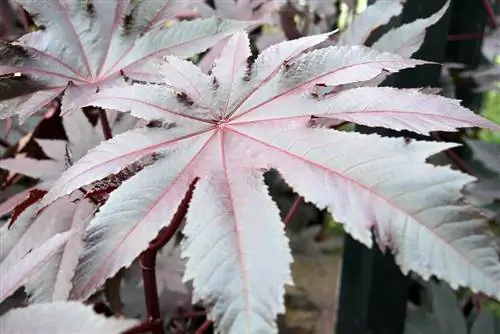
The miracle tree is equipped with a constitution for perennial cultivation. In the mild wine-growing regions of Germany, this expectation should easily be fulfilled. In autumn, the castor bean plant gradually absorbs its above-ground parts. Now give the spurge plant enough opportunity to assimilate the remaining nutrients from shoots and leaves, which will strengthen the strength reserves for the root system to overwinter. If the withered plant parts disturb the appearance, they are then removed. If your garden is in a harsher region, the following winter protection measures are recommended:
- Hill the planting site generously with leaf mold, compost, brushwood or straw
- Ideally put the pot in a frost-free, bright winter quarters
- Alternatively, place the planter on wood and wrap it with bubble wrap
- Cover the substrate with straw, leaves, brushwood or pine fronds
During a frosty winter without snowfall, Christ palms are much more likely to be at risk of drought stress than during the summer. If the ground is deeply frozen, the roots cannot reach the water. If this shortcoming is not compensated for by a blanket of snow, the spurge plant will dry out helplessly. So on a frost-free day, take a spin around the garden with the watering can, because it's not just the miracle tree that's craving water.
Toxicity
The shoots, flowers and leaves of the miracle tree contain poisonous alkaloids. These trigger allergic reactions on the skin in sensitive people. This poison content, however, is negligible compared to the toxicity of the seeds. These are found in the prickly fruits and contain the dangerous protein ricin. Just 0.25 milligrams of this substance can be fatal. There is a risk of fatal circulatory failure no later than 2 days after consuming the seeds. An antidote has not yet been developed. Because of its high potential for harm, ricin is considered a weapon of mass destruction and is subject to the United Nations Chemical Weapons Convention. Smaller amounts cause the worst he alth problems, such as nausea, vomiting or severe damage to the kidneys and liver. This is how experienced hobby gardeners deal with toxicity:
- Do not plant the miracle tree within reach of children and pets
- For reasons of caution, if in doubt, pick the fruit in good time
- Carry out all maintenance work with suitable protective clothing
- Do not dispose of harvested fruits in the compost or on pastures so that animals do not eat them
The production of the well-known castor oil, which has a wide range of uses as a medicine, therefore belongs in professional hands. Since toxic ricin is fat-insoluble, it is found in the waste after pressing.
Propagation
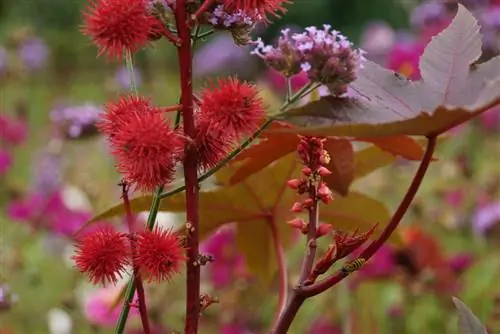
If you are aware of the toxic content of miracle tree seeds and take appropriate precautions, you can easily plant additional specimens of the impressive spurge plant in your green kingdom. It is precisely these seeds that can be used to easily grow vital young plants in early spring. Specialist retailers have suitable seeds available. This is how propagation works by sowing:
- In February, soak the seeds for 24 hours in 0.2 percent potassium nitrate from the pharmacy
- Alternatively, roughen the seeds with a file and let them soak in room temperature water
- Fill small pots with seed soil, peat-sand mixture, coconut hum or a similarly lean substrate
- Insert one seed at a time and sieve with sand or vermiculite to a thickness of 1 cm
- Moisten with water from the spray bottle and cover with cling film
Germination takes place within 3 weeks on the windowsill, although the seeds must not be exposed to direct sunlight. The cover is ventilated daily and the moisture content of the seed soil is checked, because the seeds must not dry out under any circumstances. If the cotyledons emerge from the seeds, the cling film has done its job. Now the growth is progressing so quickly that repeated repotting into larger pots is necessary before planting out in May.
Plants
In the first two weeks of May, place the young plant on the bright balcony during the day so that it is hardened by the sun's rays. The miracle tree spends the cool nights indoors. After the Ice Saints the planting time begins.
- Two weeks before the planting date, thoroughly loosen the soil at the location
- Remove weeds, roots and stones to incorporate a generous portion of compost
- On the day of planting, soak the still potted castor bean plant with water
- Dig a pit with twice the volume of the root ball
- Drainage made of pottery shards or grit prevents waterlogging
- Pour a layer of substrate over the drainage and plant the potted miracle tree
- A planting distance of 1 meter is considered appropriate
Planting in the pot is analogous, although drainage is of fundamental importance for successful care. Only fill the substrate high enough that a pouring edge remains free.
Conclusion
The miracle tree can undoubtedly be characterized as a garden plant of extremes. It displays breathtaking growth, enchants with magnificent foliage, fluffy flowers and spectacular spiky fruits in dramatic red. On the other hand, its seeds contain a dangerous poison that is deadly in the low milligram range. Processed by skilled hands, the well-known castor oil is obtained from it. Given its toxicity, planting should be avoided in gardens with children and pets. Where this precautionary measure does not apply, the Christ palm proves to be an easy-care ornamental plant in beds and containers.

